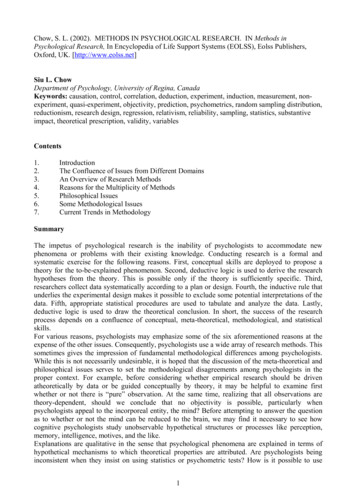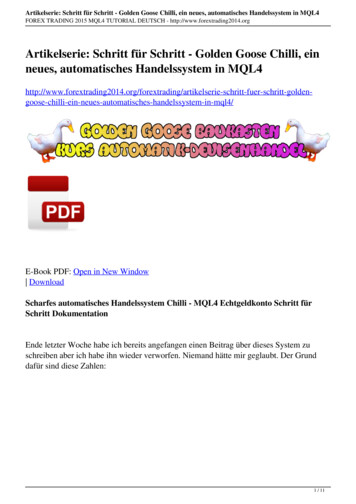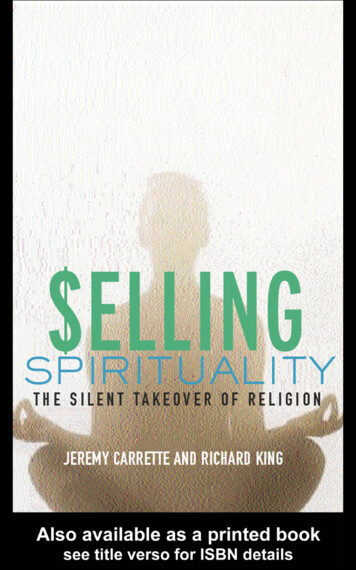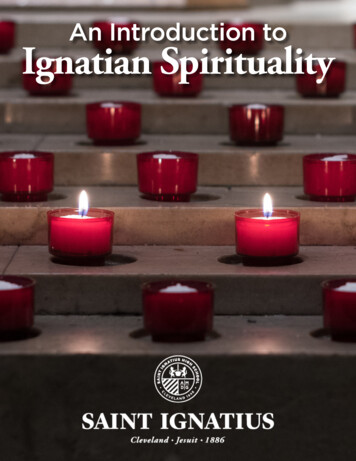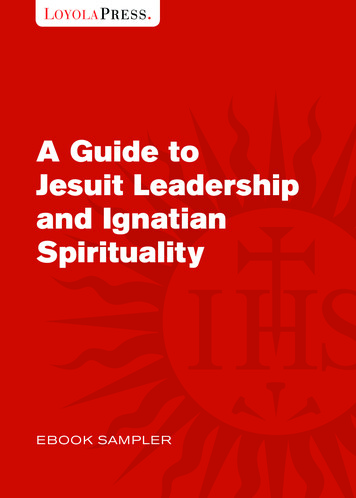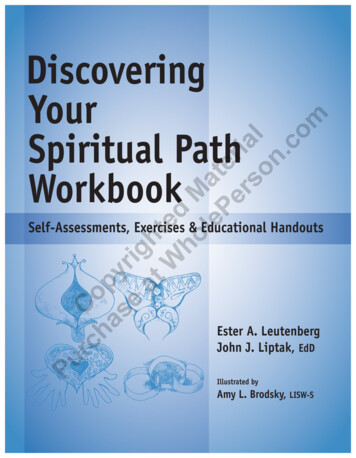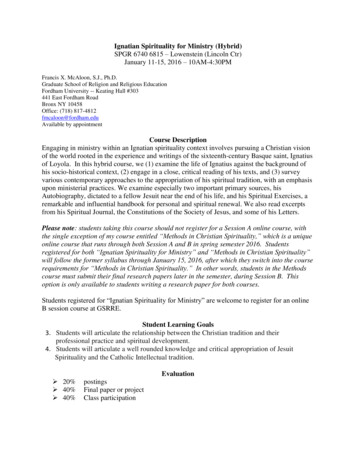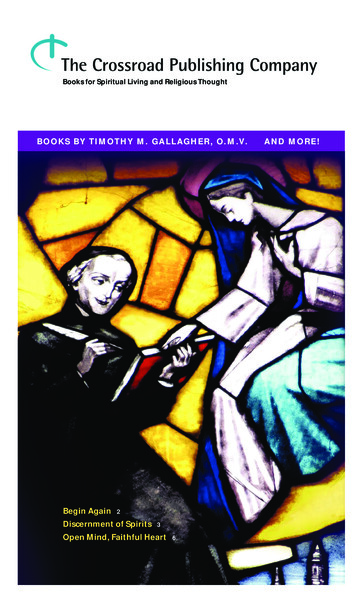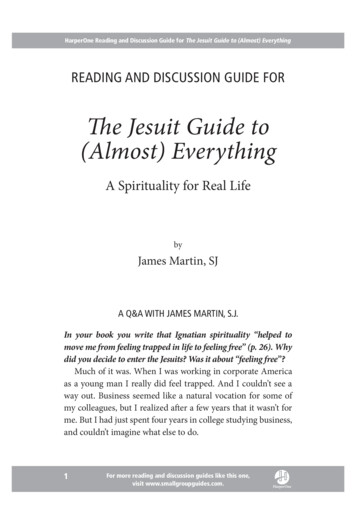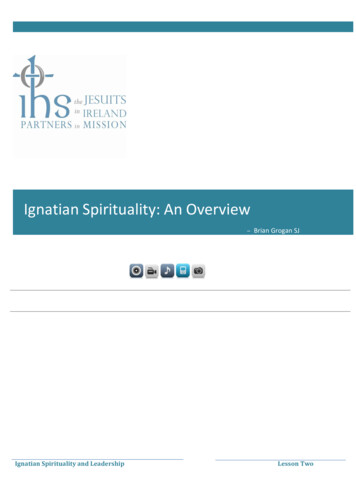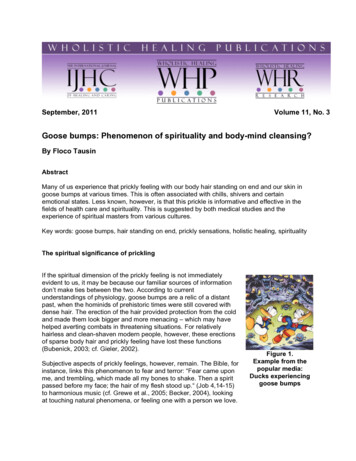
Transcription
September, 2011Volume 11, No. 3Goose bumps: Phenomenon of spirituality and body-mind cleansing?By Floco TausinAbstractMany of us experience that prickly feeling with our body hair standing on end and our skin ingoose bumps at various times. This is often associated with chills, shivers and certainemotional states. Less known, however, is that this prickle is informative and effective in thefields of health care and spirituality. This is suggested by both medical studies and theexperience of spiritual masters from various cultures.Key words: goose bumps, hair standing on end, prickly sensations, holistic healing, spiritualityThe spiritual significance of pricklingIf the spiritual dimension of the prickly feeling is not immediatelyevident to us, it may be because our familiar sources of informationdon’t make ties between the two. According to currentunderstandings of physiology, goose bumps are a relic of a distantpast, when the hominids of prehistoric times were still covered withdense hair. The erection of the hair provided protection from the coldand made them look bigger and more menacing – which may havehelped averting combats in threatening situations. For relativelyhairless and clean-shaven modern people, however, these erectionsof sparse body hair and prickly feeling have lost these functions(Bubenick, 2003; cf. Gieler, 2002).Subjective aspects of prickly feelings, however, remain. The Bible, forinstance, links this phenomenon to fear and terror: “Fear came uponme, and trembling, which made all my bones to shake. Then a spiritpassed before my face; the hair of my flesh stood up.“ (Job 4,14-15)to harmonious music (cf. Grewe et al., 2005; Becker, 2004), lookingat touching natural phenomena, or feeling one with a person we love.Figure 1.Example from thepopular media:Ducks experiencinggoose bumps
Religious and spiritual traditions of non-Western cultures point to another aspect of thisphenomenon. Prickly feelings are associated with meditative and ecstatic states, often whileexperiencing a deepdevotional love towards a deity. This is not so difficult for us tocomprehend if we remember that we know this feeling from verybeautiful moments, be it while listeningIn love and sexuality, a dermal prickling may be the result of deepand conscious relaxation of body and mind. The Kamasutra, afourth century Indian textbook of carnal love, teaches a particulartype of touch that will cause such prickling (Kamasutra 4. 10).Psychologist J. Panksepp observed neurochemical similaritiesbetween the prickly feeling and sexual orgasms – pointing to thefact that an exhilarating prickle involving the whole body is often feltduring intense orgasms. This has been called 'skin orgasm' or 'fullbody orgasm' (Panksepp 1995; cf. Becker, 2004).Figure 2:Prickling touchper the KamasutraNow we understand the deeper meaning prickling has for manymasters who transformed carnal love into spiritual love: love is notdirected to a person, but to God. The sexual orgasm is replaced bya whole body orgasm with an overwhelming and ecstatic pricklingthat resonates throughout the body.- The Indian Yoga textbook Gherandasamhita, forexample, classifies the prickly feeling as a phenomenonof bhakti, or devotional love (7,14-15).- In the Hindu epics and legends, the hair of the bodiesof heroes, yogis and gods are described as rising whenthey behold divine beings or hear timeless truths.Arjuna, the hero of the Bhagavad Gita, finds that hishair stands on end when he recognizes the universalnature of his charioteer, the god Krishna (BhagavadGita 11,14). The Bhagavata Purana, focused ondevotional love for the incarnations of Vishnu,particularly Krishna, clearly states: “How can withoutbhakti one‘s hair stand on end, without loving servicethe heart melt, without devotion the tears flow, the blissbe and one‘s consciousness be purified?” (Canto11,14,23)In religious literature, the prickly feeling is also mentioned as anaspect of deep contemplation and meditation.Figure 3.Arjuna‘s hair stands onend as he beholds godKrishna- In the Abhidhamma, the most recent part of the Buddhist Pali canon, the sensation ofprickling indicates a certain level of meditation: after the thoughts have ceased to flow,an overwhelming joy (priti) spreads throughout the whole body and may intensify to totalecstasy (cf. Guenther, 1974).
- The phenomenon is not unknown to some mystics of the Semitic religions. Churchfather Augustine (4th century) may have experienced a “holy shiver” that suddenly hascome over him and let him recognize the invisible nature of the creation of God(Confessiones by Augustinus, transl. by Georg Rapp, 1838). The 11th century Islamicmystic al-Qusayri connects goose bumps to the state of deep humility (tawadu) and thedisclosure of truth (cf. Hartmann, 1914).- The prickly feeling is often reported by members of societies that use ritual techniquesof ecstasy and trances to achieve altered states of consciousness. We haveanthropological data suggesting a close connection between goose bumps and ecstaticstates or trance from Bengal, Micronesia and South America, where the tingling is oftenassociated with the presence of super-human powers and certain states of the soul(Goodenough, 2002; McDaniel, 1989; Figge, 1973).Healing through prickling – a holistic and energetic perspectiveIf the prickly feeling is associated with devotional love, ecstasy and altered states ofconsciousness in general, we can understand it as a symptom of holistic development andhealing. But how is this phenomenon associated with healing? Could it contribute to thechanges associated with healing?To answer that question, I’d like to consider the view inspired by my teacher, Nestor, a seerand mystic living in the Swiss Emmental. In Nestor’s experience, intense prickly sensations(which he calls “ecstasy”) is excess subtle energy flowing out of the body-mind and alteringconsciousness. This consciousness change results in a more relaxed state of the body-mind,enabling the perception of subtle energetic phenomena (e.g. “eye floaters” and other so-calledentoptic phenomena, cf. Tausin, 2009). The relevance to healing is, in Nestor’s terms, thatenergy flowing out of the body dissolves subtle blockades and brings about cleansing – just assweating, urinating and defecating do on a more material level. This theory corresponds withthe Ayurvedic teaching that associates prickling with the vyana vata or vyana vayu respectively,a wind or ethereal energy that governs all circulation (cf. Sadashiva Tirtha, 2005). Generallyspeaking, prickling points to an increased subtle energy and circulation that may stand forcleansing processes.Like Ayurveda, Western academic medicine does not explicitly associate cleaning effects withthe prickle phenomenon. Rather, it is labeled as a symptom of various, often infectiousdiseases, such as cold, faint, dizziness, numbness and other problems. There are indications,however, that the prickling is, like fever, a defensive reaction of the body. For instance, certainmedicine can cause prickly feelings in patients. Interpreted from the perspective of energy, theactive agent of the medicine causes the patient’s subtle energy to flow out of the body-mindthrough the energetic processes associated with the prickly feeling and, thus, to clear body andmind of the problems that are present.There are also statistical studies suggesting that prickling sensations may have an unexploredhealth benefit. In a clinical study, J. T. Van Dissel and colleagues from Leiden UniversityMedical Center in The Netherlands (2005), evaluated the predictive value of chills, bacteriemia(presence of bacteria in the blood) and endotoxemia (presence of bacterial toxins in the blood)on in-hospital mortality and survival. Chills are understood as perception of cold and involuntarymuscle tremor. Van Dissel et al. found that patients with chills had a significantly higher survivalrate at long-term follow-up compared with those patients who do not experience chills. The
researchers suspect that, in general, patients with chills are able to respond more effectively todiseases Since chills often are associated with prickly feelings, I suggest that it is reasonableto apply the results of this study to that phenomenon, too.Let us explore further the energetic-cathartic interpretation of the cleansing effect on apsychological level associated with the prickling. Inner tensions may be made conscious andget resolved through the experience of the prickly feeling. In fear situations, for example, whereour heart races and we may tremble, it is the energy of fear that we release through our bodymind. Nestor's teaching and my own experience suggest to me that with increasing progress inany practice of conscious living addressing both, body and mind, fear symptoms like tremorsand heart palpitations will diminish and cease. This allows us not only to stay calm andcentered in such situations, but we can even learn to enjoy this energy, as when we engage insports that may involve dangers but give us a thrill. In such situations, fear is not losing itsenergy but rather losing its emotional power over us. I understand emotion as subtle energythat could not flow freely and therefore causes emotional symptoms (Tausin, 2009).Prickling in the head, which sometimes is noticed in states ofintense anger, may indicate similar releases of energies that allowus to immediately become calm and relaxed. Here, we have notsuppressed the aggression but rather have let its energy flow outof our body without being rude or even destructive to ourselves orothers. We have overcome the anger.The same happens with strong affection in love or sexuality. Aconversation with a sympathetic human being can cause arelaxing, prickly feeling. This process enables us to enjoy thatmoment free from possible oppressive constraints and desires.Also, those who try to transform their sexual energy throughTantric practices or sexual Kung Fu will increasingly experiencehair standing on end, indicating the outflow of transformed sexualenergy – by way of an ecstatic full body orgasm, which relaxesand strengthens body and mind and lets us experience a beautifuland joyful environment (cf. Chia/Winn 1984; Chia/Chia 2005).Figure 4.Tibetan MedicineBuddha: Does he healthrough his ecstaticenergy radiating fromThese are just a few examples of prickly feelings which may behis body?experienced by different people in different positive and negative emotional situations. In allthese cases, the prickly feeling is associated with bioenergetic shifts and energy releases of thebody-mind that dissolve and release emotional tensions as pure energy. The prickly feelingitself not only indicates these processes, but alerts and awakens us, through these sensations,to experience them in a attentive and conscious way.In summaryThe phenomenon of the prickly sensation indicates holistic body-mind processes which arerelevant to medicine, psychology and spirituality. With regard to healing, the pricklephenomenon may be understood as a release of subtle energy that clears the body and mind.Intensifying that process through various meditative and ecstatic exercises has been relevant tothe practice of many individuals dedicated to the spiritual quest for wisdom and self-realization.
References:Augustinus, Aurelius (n/a): Confessiones (transl. by Georg Rapp). Stuttgart 1838Becker, Judith O. (2004): Deep Listeners: Music, Emotion and Trancing. Info University PressBubenick, George A. (2003): Why do humans get “goosebumps” when they are cold, or underother circumstances? http://www.scientificamerican.com/article.cfm?id why-do-humans-getgoosebu (28.5.11)Chia, Mantak / Winn, Michael (1984): Taoist Secrets of Love: Cultivating Male Sexual Energy.Aurora PressChia, Mantak / Chia, Maneewan (2005): Healing Love through the Tao: Cultivating FemaleSexual Energy. Destiny BooksFigge, Horst H. (1973): Geisterkult, Besessenheit und Magie in der Umbanda-ReligionBrasiliens. K. AlberGieler, Uwe (2002). Warum bekommt man in besonders bewegenden Momenten eineGänsehaut? http://www.spektrumdirekt.de/artikel/591742 (24.2.11)Goodenough, Ward H. (2002): Under Heaven’s Brow: Pre-Christian Religious Tradition inChuuk. PhiladelphiaGrewe, Oliver et al. (2005): How Does Music Arouse „Chills“? Investigating Strong Emotions,Combining Psychological, Physiological, and Psychoacoustical Methods, in: Neurosciencesand Music III: From Perception to Performance. Annals of the New York Academy of Sciences1060: 446-449Guenther, Herbert V. (1974): Philosophy and Psychology in the Abhidharma. DelhiHartmann, Richard (1914): Das Sufitum nach Al-Kuschairi. J. J. AugustinMcDaniel, June (1989): The Madness of the Saints. Ecstatic Religion in Bengal. ChicagoPanksepp, J. (1995): The emotional sources of „chills“ induced by music, in: Music Perception13, 2: 171-207Sadashiva Tirtha, Swami. (2005). The Ayurveda Encyclopedia. 5. Aufl. Bayville, NY: AyurvedaHolistic Center PressSpitzer, Manfred (2002): Musik im Kopf. StuttgartTausin, Floco (2009): Mouches Volantes. Eye Floaters as Shining Structure of Consciousness,Leuchtstruktur Verlag: BernVan Dissel, Jaap T. et al. (2005): Chills in „early sepsis“: good for you? In: Journal of InternalMedicine 257: 469-472
Image sources:The pictures are taken from image hosting websites, from scientific publications (online andprint) and/or from my own collection (FT). Either they are licensed under a Creative Commonslicense, or their copyright is expired, or they are used according to the copyright law doctrine of‘Zitatrecht’, ‘fair dealing’ or ‘fair use’.Figure 1. Ducks experiencing goose duck/jesse pindus/it zp 0124a 001.jpg?o 1929 (24.2.11))Figure 2. Prickling touch per the Kamasutra. asutra/rio1714/kamasutra.jpg?o 106 (24.2.11))Figure 3: Arjuna‘s hair stands on end as he beholds god d%20gita/maniaps/TA0050.jpg?o 6 (24.2.11))Figure 4. Tibetan Medicine Buddha: Does he heal through his ecstatic energy radiating from hisbody? icine%20buddha/gwandana/buddha.jpg?o 7(24.2.11))Floco Tausin (Pseudonym)c/o Leuchtstruktur VerlagP. O. Box 1357CH-3072 Ostermundigen, n@eye-floaters.infoTERMS OF USEThe International Journal of Healing and Caring On Line is distributed electronically as anopen access journal, available at no charge. You may choose to print your downloaded copyof this article or any other article for relaxed reading.We encourage you to share this article with friends and colleagues.The International Journal of Healing and Caring – On LineP.O. Box 76, Bellmawr, NJ 08099Phone (609) 714-1885 Fax (519) 265-0746Email: center@ijhc.org Website: http://www.ijhc.orgCopyright 2011 IJHC. All rights reserved.DISCLAIMER: .html
mystic al-Qusayri connects goose bumps to the state of deep humility (tawadu) and the disclosure of truth (cf. Hartmann, 1914). - The prickly feeling is often reported by members of societies that use ritual techniques of ecstasy and tr

